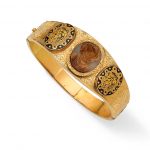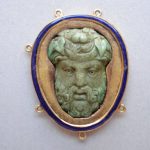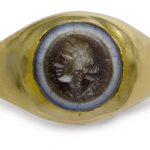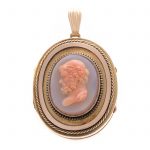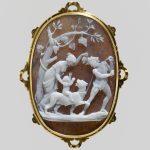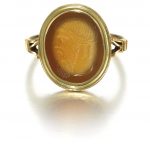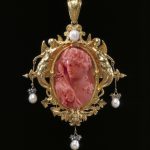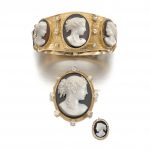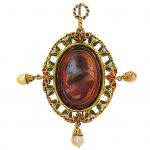Information on Bacchus the Roman god of wine including cameos depicting the Roman god. Bacchus was the Roman god of agriculture, wine and fertility copied from the Greek god Dionysus. Dionysius was the last god to join the twelve Olympians; Hestia gave up her seat for him. His plants were vines and twirling ivy. He often carried a pinecone-topped staff, and his followers were goat-footed Satyrs and Maenads, wild women who danced energetically during his festivals.
Bacchus was the child of Jupiter (whose Greek name is Zeus) and Semele, a human whom Juno (whose Greek name is Hera) had tricked into asking to see Jupiter as he really was. Since she was a mortal, she was burned up by the sight of Jupiter in his divine form. So Jupiter sewed the infant Bacchus into his thigh, and gave birth to him nine months later. As a child, Bacchus was tutored by Silenus, who was a great lover of wine and often had to be carried on the back of a donkey. Before he took his place at Olympus, Bacchus wandered the world for many years, going as far as India to teach people how to grow vines. Reference: Wikipedia
An enamel and hardstone cameo bangle, circa 1860 The oval hardstone carved in relief to depict Bacchus, between two oval panels of grape vines decorated in black enamel, to a tapered bangle with engraved floral and foliate motifs, inner diameter 6.2cm
Sold for £ 1,125 inc. premium at Bonhams in 2016
Cameo; turquoise; bearded head of Bacchus to front, wearing ivy-wreath; in gold mount with blue enamel and six loop projections. Date16thC
Reference: © The Trustees of the British Museum
A ROMAN BANDED AGATE RINGSTONE WITH A HEAD OF BACCHUS CIRCA 1ST CENTURY B.C.-1ST CENTURY A.D. Mounted as a ring in a modern gold setting 5/16 in. (.8 cm.); ring size 9
Sold for USD 2,000 at Christies in 2016
A Victorian Bacchus Cameo Locket in Gold c.1890, Victorian, 14K yellow gold locket with oval sardonyx cameo depicting Bacchus measuring 28 x 35mm, 1.75 in. L, 20.7 grams
Sold for $500 at Alex Cooper in 2017
Education of the Infant Bacchus Niccolò Amastini (born Rome 1780–1851)
Freely adapting antique compositions, Niccolò Amastini described with elegant linearity the contours of the baby god and his wild attendants under a vine-wrapped tree.
Reference: The Metropolitan Museum of Art
Attributed to Lorenz Natter (1705-1763) German, circa 1750 RING WITH AN INTAGLIO WITH THE HEAD OF BACCHUS agate, set in gold bezel: 15mm., 9/16 in. ring size: E
Sold for 2,500 GBP at Sothebys in 2015
Pendant with a coral cameo depicting Bacchus, the sculpted gold frame decorated with winged mermaids and hung with pearls and diamond sparks. Circa 1854
Coral has been used in jewellery since antiquity. Believed to be an amulet which could protect against the evil eye, it was often worn by children or used in rosaries. In the early 19th century, it began to be exploited in conventional jewellery and became highly fashionable. According to the 19th century French jeweller Henri Vever ‘Every day, the coral merchant of H.R.H. Madame, Duchesse d’Angouleme, offers the most elaborate and elegant parures to customers and passers-by: the jewels which are sold there are created with exquisite taste’. Many 19th century designers used historical styles. This piece looks back to the elaborate pendants of the Renaissance with their intricately sculpted gold. It has two matching brooches. The pendant and brooches were probably one of the last sets of jewellery to be sold by the Paris jeweller François-Désiré Froment-Meurice before his death in 1855. This pendant is similar to an item his widow showed at the Paris Universal Exhibition in 1855. It is carved with a figure of Bacchus, the Greek god of wine.
Reference: © Victoria and Albert Museum
